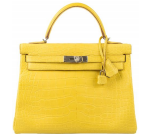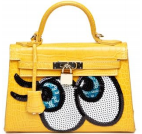Practice Notes Free-riders please disembark: Supreme Court renders unfair competition decision in Hermès bag case
Is it unfair competition to add a newly created image to a bag similar in appearance to a bag well-known among consumers as being produced by luxury brand Hermès?
Summary
In a July 9, 2020 decision (case 2017da217847), the Korean Supreme Court considered whether the defendant’s acts of manufacturing/selling a bag of which the front, side, handle, cover, leather strap (belt design), and clasp were similar in appearance to those of the well-known luxury-brand Hermès’ bag (shown on the left below), but to which the defendant had added a large image of cartoon-style eyes (shown on the right below), fall under the provisions of the Unfair Competition Prevention and Trade Secret Protection Act (hereunder “Unfair Competition Act”).
|
|
|
|---|---|
 |
 |
As Hermès did not have registered design or trademark rights in the bags relevant to this matter (namely the Birkin/Kelly bags), the complaint was based on unfair competition law.
The court ruled that provisions of the Unfair Competition Act relating to causing source confusion (Article 2-1(a)) and tarnishing distinctiveness/reputation (Article 2-1(c)) did not apply, but in contrast with the earlier instance decision did deem that the ‘catch-all’ provision of unfairly appropriating the results of others’ efforts was applicable (Article 2-1(j) in the applied version of the law in this case, but Article 2-1(k) in the current Act, shown below).
Relevant Law
Unfair Competition Act — Article 2-1
The term “act of unfair competition” means any of the following acts:
…
(k) Any other acts of infringing on other persons’ economic interests by using the outcomes, etc. achieved by them through substantial investment or efforts, for one’s own business without permission, in a manner contrary to fair commercial practices or competition order
Decision
In the earlier instance decision, the High Court stated that the defendant’s bag, which was marketed under the slogan “Fake for fun”, included the defendant’s original image covering most of the front of the bag, with the unfamiliar combination of various mixed images expressing creativity and realizing a new aesthetic. Giving general consideration to the creativity and cultural value of the defendant’s product, as well as the defendant’s promotion/sales activity and marketing strategy, the High Court went on to state that the defendant’s actions were not deemed to entail free-riding on the fame of Hermès’ products, and did not violate fair commercial practices or competition order.
Further, the High Court stated that as the defendant’s products used shiny, inexpensive artificial leather and sparkly sequins which Hermès does not use, and the price of the goods, sales locations/methods and main customer base were also distinctly different, there was little chance of the defendant’s products being confused for Hermès’ products. For this reason, there was seen to be little concern that the defendant’s manufacture and sales activities would cause economic harm to Hermès or reduce Hermès’ market advantage, and so the defendant’s actions were not deemed to be infringing on other persons’ economic interests as required by Article 2-1(j) of the applied version of the Unfair Competition Act.
However, the Supreme Court reached a different conclusion, stating that despite the ‘Fake for fun’ slogan, the form of the defendant’s bag was similar to Hermès’ and the intent to free-ride on the fame and awareness of Hermès’ bags is apparent; commercially selling a product by adding a new image to an item already widely known among consumers as that of another party cannot be seen as being in keeping with fair commercial practices or competition order. The Supreme Court noted that in order to utilize an item widely known among consumers as that of another party, an example of fair commercial practice would be cooperation/collaboration under a contract.
The Supreme Court went on to state that Hermès limits the supply of their bags relevant to this case (the Birkin/Kelly bags), and the defendant’s sales of similar products could be an obstacle to maintaining their scarcity. Further, if the defendant was to continue manufacturing and selling their bag domestically, it could have an effect on the demand for Hermès products or result in potential consumers not purchasing Hermès products due to their scarcity or depreciation in value.
Based on the above, the Supreme Court quashed the earlier decision and remanded the matter to the High Court, stating that the law was incorrectly applied when determining that the defendant’s actions did not come under the definition of unfair competition.
Take-aways
The Supreme Court exemplified cooperation/collaboration under a contract as being fair commercial practice, while having an intention to free-ride is not. As to how an intention to free-ride may be determined, it appears that the level of fame and awareness of the other party’s goods are important. As to whether economic interests are infringed, practical factors such as scarcity and depreciation (dilution) were considered. In the absence of practically any other remedy, the Supreme Court applied the general/supplemental ‘catch-all’ clause of the Unfair Competition Act, and in consideration of all of the above factors, I think that the Supreme Court’s determination that the defendant’s actions constitute unfair competition is appropriate.
Based on this decision we must keep in mind that even for unregistered IP rights, if the original product is the result of substantial investment or efforts, any non-authorized commercial use could be considered an act of unfair competition, even if there is recognized to be separate creativity in the resulting product.
Written by Jae-sang LIM, Ben YUU